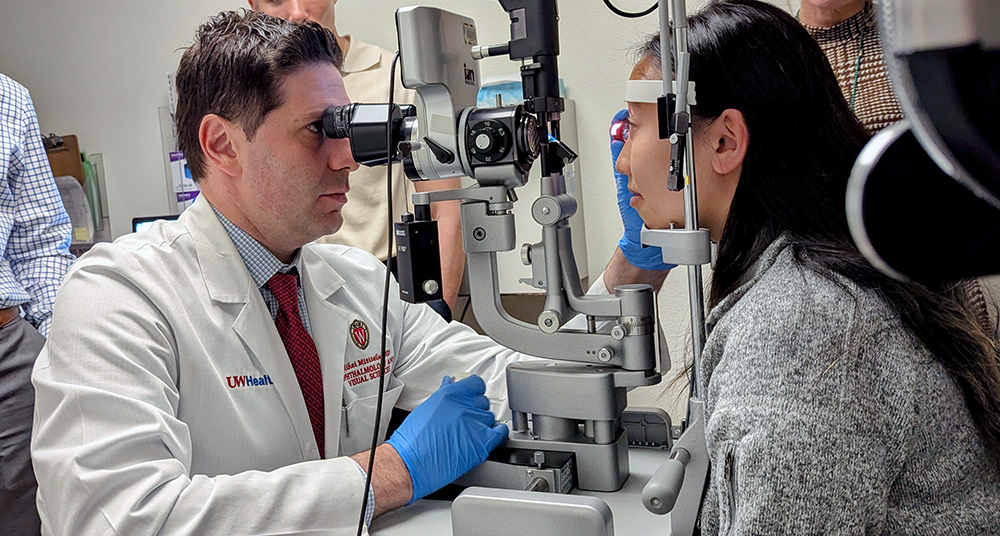The Clinical Eye Research Unit (CERU) is an academic research organization within the University of Wisconsin Department of Ophthalmology and Visual Sciences (DOVS) dedicated to advancing ophthalmic care by developing and implementing protocols to prevent and treat eye disease. CERU specializes in conducting clinical trials, translational research, and research education services, while also fostering multi-disciplinary collaborations.
New Team Members
The CERU continues to evolve and expand. Over the past year, four key positions within the unit were successfully filled. Angie Adler, BS, CCRC was selected as the new CERU Clinical Research Manager. She has been a member of the research unit for 18 years, during which she has held various roles, including study coordinator, regulatory specialist, and research supervisor.
“I am honored to continue my professional journey in this new and exciting role. I look forward to collaborating with the CERU team, as well as with our study participants, investigators, sponsors, members of our department and the broader UW community,” Adler said.
In her new position, she will work closely with CERU Medical Director Mihai Mititelu, MD, MPH, FASRS, and Christina-Thomas Virnig, PhD, Director of Translational Research and CERU administrative liaison, to help shape the unit’s ambitious strategy of growth and development.
In addition, Nicole Boone joined the unit in November 2024 as a Clinical Research Coordinator, bringing a passion for both education and research. In June 2025, Meg Hackbarth and Matt Gilles were welcomed to CERU as Regulatory Coordinators. Both bring a wealth of experience in protocol process and oversight, collaborating closely with investigators, study participants and sponsors.
Additional Space
CERU has acquired a portion of the patient check-in area on the third floor of University Station Eye Clinic to be used for conversion into dedicated patient care and research space. Construction was initiated this past fall, allowing for the optimization of space in other areas. Additionally, CERU has remodeled a room in the same building to house a functional vision mobility maze for a newly launched Phase 1 clinical trial.
“The growth of our space and team reflects the unit’s continued relevancy and translational importance, offering an expanded and increasingly diverse portfolio of research opportunities for our patients,” said Dr. Mititelu. “Over the past five years, we’ve nearly doubled the number of studies we offer.”
Expanding Partnerships
In the past year, CERU investigators and staff have contributed to more than 90 research projects, including federal and industry-sponsored trials, investigator-initiated studies, databases, and collaborations.
The unit has launched several new and promising clinical trials investigating a wide range of ocular conditions, including exudative age-related macular degeneration, radiation retinopathy, and inherited retinal diseases. DOVS faculty, in collaboration with CERU, have also initiated multiple investigator-initiated studies focused on areas such as geographic atrophy, retinal imaging, and diabetic retinopathy, among others.
CERU also supports clinical trials initiated by various departments within the University of Wisconsin—Madison School of Medicine and Public Health, thus expanding its collaborations across campus to include UW Hospital, the Carbone Cancer Center, and the School of Veterinary Medicine. There are collaborations with other departments across campus as week, including Neurology and Nephrology. The unit provides expertise in all ophthalmology-related aspects of collaborative trials.
“Our partnership with Carbone Center is particularly important and has been experiencing steady growth over the past five years,” added Dr. Mititelu. “A number of both existing and experimental cancer treatments have potential ocular side-effects, many of which we are the first ones to identify. The trials evaluating these new therapies have specific protocols for monitoring study participants. Our team coordinates all eye-related aspects of the research protocol, including ophthalmology exams and ancillary testing. By serving as a central resource, our unit is uniquely poised to support every patient who decides to participate in a cancer clinical trial that has the potential to impact vision.”
In October 2024, CERU principal investigators and staff led a course titled “Orchestrating Clinical Research in Ophthalmology – A Sites Guide for Initiating Clinical Research in Your Practice” at the American Academy of Ophthalmology annual meeting in Chicago. Since then, CERU has partnered with an Idaho ophthalmology practice to support the growth of their clinical trials infrastructure. In addition to providing opportunities for shadowing staff, the CERU has created guidelines regarding research staffing and training, feasibility assessments, registry development, EMR integration, business development, network building, and trial identification.
“The CERU team would like to express their sincere gratitude to all the faculty who have graciously shared their time and expertise by participating in clinical trials,” said Dr. Mititelu. “The unit’s success is a direct reflection of their commitment to advancing ophthalmology through every facet of clinical research.”

